Colorado School of Mines
Colorado School of Mines (Mines) is a public research university in Golden, Colorado, founded in 1874. The school offers both undergraduate and graduate degrees in engineering, science, and mathematics, with a focus on energy and the environment. While Mines does offer minor degrees in the humanities, arts, and social sciences, it only offers major degrees in STEM fields, with the exception of economics. In the Fall 2023 semester, the school had 7,101 students enrolled, with 5,443 in an undergraduate program and 1,658 in a graduate program.[4] The school has been co-educational since its founding, however, enrollment remains predominantly male (68.5% as of Fall 2022).[4] It is classified among "R1: Doctoral Universities – Very high research activity".[8]
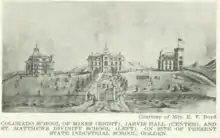
 | |
Former name | Territorial School of Mines (1874–1876) |
|---|---|
| Motto | Nil sine numine (Latin) |
Motto in English | "Nothing without God's will." |
| Type | Public research university |
| Established | February 9, 1874[1] |
| Accreditation | HLC |
Academic affiliations | Space-grant |
| Endowment | $285.6 million (2020)[2] |
| President | Paul C. Johnson |
| Provost | Richard C. Holz |
Academic staff | 603[3] |
| Students | 7,101 (fall 2023)[4] |
| Undergraduates | 5,443 (fall 2023)[4] |
| Postgraduates | 1,658 (fall 2023)[4] |
| Location | , , United States 39°45′4″N 105°13′21″W |
| Campus | Large Suburb, 373 acres (1.51 km2)[5] |
| Newspaper | The Oredigger |
| Colors | Blue and silver[6] |
| Nickname | Orediggers |
Sporting affiliations | NCAA Division II – Rocky Mountain |
| Mascot | Marvin the Miner Blaster the Burro[7] |
| Website | www |
History
19th Century
Golden, Colorado, established in 1859 as Golden City, served as a supply center for miners and settlers in the area. In 1866, Bishop George M. Randall of Massachusetts arrived in the territory and, seeing a need for higher education facilities in the area, began planning for a university which would include a school of mines. In 1870, he opened the Jarvis Hall Collegiate School in the central building of the Colorado University Schools campus just south of the town of Golden, accompanied it with Matthews Hall divinity school in 1872, and in 1873 the School of Mines opened under the auspices of the Episcopal Church. In 1874 the School of Mines, supported by the territorial government since efforts began in 1870, was acquired by the territory and has been a state institution since 1876 when Colorado attained statehood. Tuition was originally free to residents of Colorado.
In 1878, Jarvis Hall’s main building and Matthews Hall were both destroyed by fires in the span of two days. The School of Mines building was the only structure of the complex left standing. Following the fires, the School of Mines enrollment grew, consisting of prospectors and mine owners. A school library was established with $250, and a gymnasium was built to support the growing student body. The school's fight song, "The Mining Engineer", the first two verses of which are still sung today, was established on campus by 1885.[9]
Following the 1880s, the School of Mines transitioned to become a 4-year university, removing its assaying certificate program. Around this time, silver and blue began to be seen as the official school colors. In 1894, Engineering Hall was completed. As the oldest building on campus, Engineering Hall originally housed the physics and drafting departments, but now houses the Division of Economics and Business.[10] The following year, the CSM Alumni Association was founded with members wearing the first instance of the school's Reuleaux triangle symbol. In 1898, Florence Caldwell became the first female graduate of the School of Mines, earning a Civil Engineering Degree.[11]
20th Century
At the turn of the century, the School of Mines officially changed its name to Colorado School of Mines. In 1905, Simon Guggenheim donated the largest private donation to the school at the time, $80,000, for the construction of Guggenheim Hall to honor his family history in Colorado.[12] The first experimental mine owned by the Colorado School of Mines is built into Mount Zion. Also known as the School Tunnel, it served to train mining engineers and is now incorporated into the basement of a house on the mountain. Also on Mount Zion, the large "M" is constructed based on a senior thesis to make it proportional when viewed from campus.[13]
Colorado School of Mines - University of Denver Rivalry
Tensions between Colorado School of Mines and the University of Denver, locked in a bitter rivalry, boiled over in 1919 when the Orediggers heard of a plot to deface the M on Mount Zion. In retaliation to the plot, students from Colorado School of Mines planted bundles of dynamite on the DU campus which, when detonated in the early morning, blew out windows in many buildings and cracked the DU administration building.[14] The chancellor of DU stated that “if all the dynamite planted on our campus had exploded simultaneously, it would have knocked down our buildings and destroyed life."[15]
Additionally, Colorado School of Mines students paraded DU students down the streets of Golden and implemented armed patrols on Mount Zion, claiming the right to search all vehicles for concealed DU students. Colorado School of Mines President, Victor C. Alderson, sanctioned the actions of the students; however, Colorado governor Oliver Shoup asked the schools to seek a truce. Representatives from both schools agreed to cease and opted for a game of football to settle the conflict. The game was played on a snowy day and resulted in a 0-0 tie.[14]
University of Colorado Boulder Bell Heist
Campus legend states that the bell that used to hang in Guggenheim Hall was stolen by students from the University of Colorado Boulder and held on their campus. In 1948, a group of mostly GIs decided to return the bell to the Guggenheim Hall. 18 men, all students at Colorado School of Mines, drove to Boulder to locate the bell and discovered that it was behind a locked door with a night guard. Returning to Golden empty handed, they returned weeks later with more students to steal the bell.[16]
On their second attempt, a student who had been planted inside the building before it closed opened the doors and they proceeded to lift the 1,200 pound bell onto a dolly out to a truck. The bell was reported stolen by CU, and was said to be their "Old Main" bell. According to the Silver and Gold, CU's campus newspaper, the bell always belonged to CU.
After returning to Golden, the Colorado School of Mines students quickly realized the bell was too big to ever have hung from Guggenheim. Unwilling to return the bell, they buried it in the clay pits adjacent to campus and left it for their time at the college. In 1950, the bell was dug up and placed behind Guggenheim Hall with an M etched into it. The CU administration immediately requested to retrieve the bell, but the Mines administration refused to authorize it until CU provided proof of ownership. 10 days later, CU provided a receipt from the bell caster, and it was returned to be displayed in the CU heritage center with an M clearly on display.[17]
21st Century

In August 2007, a new student recreation center was completed. In 2008, the school finished expanding its main computer center, the Center for Technology and Learning Media (CTLM). In May 2008 the school completed construction and installation of a new supercomputer nicknamed "Ra"[18] in the CTLM managed by the Golden Energy Computing Organization (GECO), a partnership among the Colorado School of Mines, the National Renewable Energy Laboratory, the National Center for Atmospheric Research and the National Science Foundation. In 2014, CoorsTek granted a $27 million investment to the university, leading to the 2017 opening of the CoorsTek Center for Applied Science and Engineering, a multi-disciplinary building on campus dedicated to both academic and research activities.[19]
Since 1964, the Colorado School of Mines has hosted the annual oil shale symposium, one of the most important international oil shale conferences. Although the series of symposia stopped after 1992, the tradition was restored in 2006.[20]
Presidents
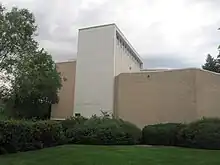
|
Campus
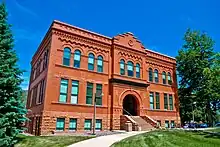
Colorado School of Mines is located to the southwest of Golden's downtown, bordered by U.S. Route 6 and Clear Creek. The campus spans 373 acres (1.51 km2),[5] and includes over a dozen academic and research buildings, indoor and outdoor athletic facilities, two student centers, a library, eight residential halls, and administration buildings. Additionally, the campus hosts a research building for the United States Geological Survey,[21] housing the National Earthquake Information Center.
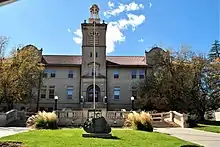
Colorado School of Mines also operates the free admission Mines Museum of Earth Science, which displays rock and mineral specimens collected from Colorado's numerous mining districts, as well as around the world. Notable objects in the collection include one of the "Goodwill" Apollo 17 lunar samples and the Miss Colorado crown.[22][23]
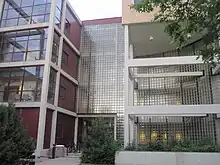
Academics
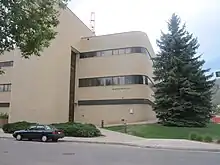
Mines began the world's first graduate program in space resources in the fall semester of 2018, offering both master's and PhD degrees.[25]
In 1921, the Colorado School of Mines bought Edgar Mine in nearby Idaho Springs, Colorado. The experimental mine features a classroom, a train, and an extensive network of tunnels.[26]
Rankings
| Academic rankings | |
|---|---|
| National | |
| Forbes[27] | 94 |
| THE / WSJ[28] | 169 |
| U.S. News & World Report[29] | 88 |
| Washington Monthly[30] | 78 |
| Global | |
| ARWU[31] | 601–700 |
| THE[32] | 401–500 |
| U.S. News & World Report[33] | 503 |
|
USNWR departmental rankings[34] | |
|---|---|
| Chemistry | 96 |
| Computer Science | 91 |
| Earth Sciences | 28 |
| Engineering | 59 |
| Mathematics | 117 |
| Physics | 71 |
- Tied for 36th in U.S. News & World Report's 2024 "Top Public Schools" in the U.S.[34]
- 52nd in U.S. News & World Report's 2024 "Best Engineering Graduate Schools" in the U.S.,[34] with the Petroleum Engineering program ranked third.[35]
- Tied for 76th in U.S. News & World Report's 2024 "Best National Universities Rankings".[34]
- 83rd out of 174 schools ranked in Kiplinger's Personal Finance magazine's 2019 "Best Values in Public Colleges."[36]
- 9th in "USA Today's Top 10 Engineering Schools 2015".[37]
Admissions
For freshmen entering Fall 2021, Colorado School of Mines received 12,022 applications, accepted 6,838 (56.9%) and enrolled 1,449 (12.1% of those who applied).[38] The middle 50% range of SAT scores for the enrolled freshmen was 650–720 for evidence-based reading, and 660–750 for math, while the ACT Composite range was 29–33.[38] The average GPA was 3.84. Of the incoming class, 32.7% were women.[38]
Traditions
M Climb
Freshmen students at Colorado School of Mines are expected (but not required) to participate in the M Climb during orientation week. During this climb, students carry a ten-pound rock up Mt. Zion. Before ascending up the mountain, students are given colored hard-hats, which are spray-painted by members of the Blue Key Honor Society.[39] Along the climb, non-freshmen encourage the new students with water balloons, silly string, and lead the new students in learning the Mines' fight song. At the top of the mountain, students place their rock on the "M," a large sign made of rocks in the shape of Mines' M logo, and paint the M white using whitewash.[40] On graduation, seniors are invited to take a rock from the M as a keepsake of their time at Mines.[41]
E-Days
Beginning in 1934, Mines students have celebrated Engineering Days during the spring semester.[42] During E-Days, classes are canceled and students attend a variety of events beginning with the ore cart pull. Students take turns pulling an ore cart down 7.5 miles of Colfax Avenue to the state capitol building, where the governor of Colorado officially declares the start of E-Days.[43] E-Days continues with field events, tech demos, concerts, comedians, manual mining competitions, and a trebuchet contest. The next morning, teams race cardboard boats down Clear Creek, competing to see which team sails the farthest before sinking. A carnival is held during the day and the Formula SAE club hosts a car show.[44]
Silver Diplomas
The tradition of awarding silver diplomas was started in 1934 by Charles Hull, an Instrument Designer at Mines.[45] In 1935, President Herbert Hoover, who was a guest at the commencement ceremonies, was awarded an honorary Doctorate of Engineering for his contribution in translating De re metallica from Latin to English.[46]
Blaster the Burro
In the 1930s, a Golden local began to bring his donkey to football games. The donkey quickly became the school mascot, now known as "Blaster the Burro".[47]
Athletics
Colorado School of Mines was ranked No. 3 Best NCAA D2 school in the U.S. for student-athletes, according to Next College Student Athlete's 2018 NCSA Power Rankings.[48] The NCSA Power Rankings recognize the best colleges and universities in the U.S. for student-athletes.[49]
In 2022, the Orediggers won their third national title in mens cross country, posting the largest margin of victory in meet history with 143-points.[50] In December 2022, Oredigger football played in their first NCAA Division II national championship in McKinney, Texas, and lost to Ferris State 41-14.[51]
Notable alumni
.jpg.webp)
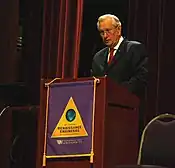 Arden L. Bement Jr.
Arden L. Bement Jr.
former director of the National Science Foundation (NSF) and the National Institute of Standards and Technology (NIST)


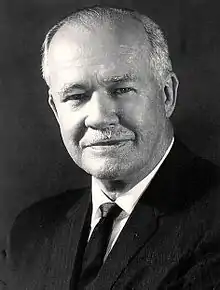 Wendell Fertig
Wendell Fertig
civil engineer, organized and commanded an American-Filipino guerrilla force on the Japanese-occupied Philippines during World War II
 Purnomo Yusgiantoro
Purnomo Yusgiantoro
president-secretary general of OPEC, former Indonesian Minister of Energy for three presidents, and former Minister of Defense in the Second United Indonesia Cabinet George Saunders Award-winning American writer of short stories, essays, novellas, children's books, and novels. Professor at Syracuse University.
George Saunders Award-winning American writer of short stories, essays, novellas, children's books, and novels. Professor at Syracuse University.
References
Informational notes
- Professor in Charge.
- Began as Professor in Charge, became the first President.
- Served as President two times
Citations
- "History of the Colorado School of Mines".
- As of June 30, 2020. U.S. and Canadian Institutions Listed by Fiscal Year 2020 Endowment Market Value and Change in Endowment Market Value from FY19 to FY20 (Report). National Association of College and University Business Officers and TIAA. February 19, 2021. Retrieved February 20, 2021.
- . Colorado School of Mines Faculty https://ir.mines.edu/wp-content/uploads/sites/66/2022/06/CDS22.pdf Faculty. Retrieved January 5, 2023.
{{cite web}}: Check|url=value (help); Missing or empty|title=(help) - "Fall Headcount Enrollment". Colorado School of Mines. Retrieved August 21, 2020.
- "Mines by the Numbers". Colorado School of Mines.
- Mines Graphic Standards Guide (PDF). Archived from the original (PDF) on October 10, 2015. Retrieved September 14, 2016.
- Blaster – Burro or Mule? Archived April 20, 2008, at the Wayback Machine
- "Carnegie Classifications Institution Lookup". carnegieclassifications.iu.edu. Center for Postsecondary Education. 2022. Retrieved February 4, 2022.
- Dunn, Lisa. "Library Guides: Timeline, Colorado School of Mines History: 1880's". libguides.mines.edu. Retrieved February 23, 2023.
- "Engineering Hall". Campus Tour. Retrieved February 23, 2023.
- "Florence Caldwell Achievement Scholarship". Women in Science, Engineering and Mathematics at Mines. Retrieved February 23, 2023.
- Vessa, Christina (October 3, 2017). "A Lasting Showpiece: Guggenheim Hall's legacy after more than 100 years on campus". Mines Magazine. Retrieved February 23, 2023.
- "The M on Mt. Zion". Campus Tour. Retrieved February 23, 2023.
- "A great rivalry: Mines battles Denver in 1919 – The Oredigger". oredigger.net. Retrieved February 23, 2023.
- "The University's 1919 "War" With School of Mines". University of Denver. November 6, 2019. Retrieved February 23, 2023.
- Benchley, Robert (October 25, 2012). "Boulder Bell Heist: Miners Break 64-year Silence". Mines Magazine. Retrieved February 23, 2023.
- "The Old Main Bell". Alumni Association. June 1, 2009. Retrieved February 23, 2023.
- Mines unveils energy supercomputer 'Ra' Archived May 16, 2008, at the Wayback Machine
- CoorsTek Center for Applied Science and Engineering - Campus TourArchived July 22, 2020, at the Wayback Machine
- Purga, Jaanus (2006). "26th Oil Shale Symposium in Golden – waking up the largest oil shale reserve in the world" (PDF). Oil Shale. A Scientific-Technical Journal. Estonian Academy Publishers. 23 (4): 385–386. ISSN 0208-189X. Retrieved July 9, 2009.
- "U.S. Geological Survey and Colorado School of Mines announce long-term partnership". Department of the Interior, U.S. Geological Survey. October 22, 2018. Retrieved August 20, 2020.
- "MInes Museum - Campus Tour". tour.mines.edu. Colorado School of Mines. Retrieved August 20, 2020.
- "Home - Mines Museum of Earth Science". mines.edu. Colorado School of Mines. Retrieved August 20, 2020.
- "Alderson Hall". Jefferson County Place Names Directory. Retrieved October 2, 2016.
- School Of Mines Debuts The world's first degree program for space mining, Colorado Public Radio, August 13, 2018. Retrieved August 17, 2018.
- Mosch, David (2013). "Underground Opening and Support Facilities of the Edgar Experimental Mine" (PDF).
- "Forbes America's Top Colleges List 2023". Forbes. Retrieved September 22, 2023.
- "Wall Street Journal/Times Higher Education College Rankings 2022". The Wall Street Journal/Times Higher Education. Retrieved July 26, 2022.
- "2023-2024 Best National Universities". U.S. News & World Report. Retrieved September 22, 2023.
- "2022 National University Rankings". Washington Monthly. Retrieved September 13, 2022.
- "ShanghaiRanking's Academic Ranking of World Universities". Shanghai Ranking Consultancy. Retrieved February 25, 2023.
- "World University Rankings 2024". Times Higher Education. Retrieved September 27, 2023.
- "2022-23 Best Global Universities Rankings". U.S. News & World Report. Retrieved February 25, 2023.
- "Colorado School of Mines Rankings". U.S. News & World Report. 2023. Retrieved September 28, 2023.
- "Best Petroleum Engineering Programs". U.S. News & World Report. 2023. Retrieved September 28, 2023.
- "Colorado School of Mines Ranking". Kiplinger's Personal Finance. July 2019.
- "The top 10 engineering colleges in the U.S." USA Today. Archived from the original on October 11, 2015. Retrieved May 26, 2017.
- "Colorado School of Mines Common Data Set 2021-2022" (PDF). Colorado School of Mines.
- Rusch, Emilie (August 13, 2019). "Incoming students to kick off academic year with M Climb". Mines Newsroom. Retrieved July 25, 2020.
- White, Mekialaya (August 17, 2019). "School Of Mines Freshmen Tackle 'M Climb' Tradition". CBS Denver. Retrieved July 25, 2020.
- "History and Traditions". Colorado School of Mines. Archived from the original on April 26, 2020. Retrieved April 26, 2020.
- "Mines to travel Around The World In EightE-Days March 31-April 2". www.minesnewsroom.com. Retrieved February 23, 2023.
- "Ore Cart Pull". Mines Activities Council. Retrieved February 23, 2023.
- "SAE Car Show". Formula SAE. Retrieved February 23, 2023.
- The History of the Silver Diploma, retrieved March 6, 2023
- Dunn, Lisa. "Library Guides: Timeline, Colorado School of Mines History: 1930's". libguides.mines.edu. Retrieved February 23, 2023.
- McPherson, Doug (April 11, 2016). "Animal Magnetism: How Blaster the Burro Found Love, and a Home, at Mines". Mines Magazine. Retrieved February 23, 2023.
- "NCAA Division 2 Colleges, NCSA College Power Rankings 2018". NCSA College Power Ranking Report. Retrieved February 14, 2019.
- "NCSA College Power Rankings of Top Athletic & Academic Universities". NCSA College Power Ranking Report. Retrieved February 12, 2019.
- "National champs! Mines wins NCAA Division II Men's Cross Country Championship". www.minesnewsroom.com. Retrieved January 9, 2023.
- ncaa.com. "Ferris State repeats as DII football national champions | NCAA.com". www.ncaa.com. Retrieved January 9, 2023.